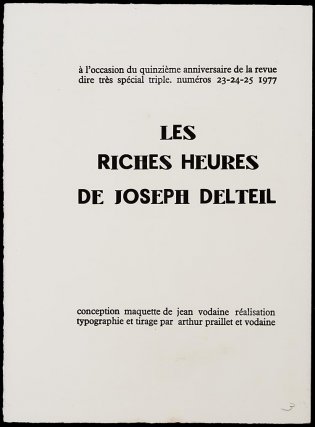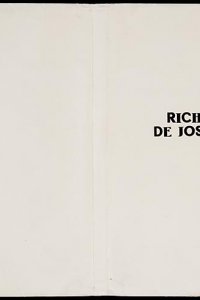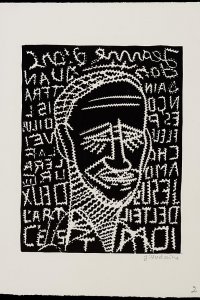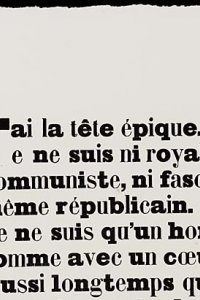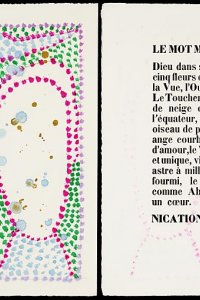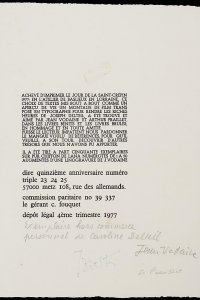Les riches heures de Joseph Delteil
Year: 1977
Author: Joseph Delteil (1894 - 1978)
Artist: Jean Vodaine (1921 - 2006)
Publisher: Jean Vodaine
Typographical interpretation
The homage is in fact an anthology of Delteil's work, beginning with a self-portrait. The first line is: 'I have an epic head', in other words: he is suited to heroic poetry. He tells us in a single breath that he is 'no royalist, no communist, no fascist, not even a republican'. He is nothing 'more' than a human being, but this first fragment does end with a homage to mankind, therefore including himself: 'I sing Mankind's praises' - with a capital M. Vodaine has made this first text something special with its typical unstable typography: thick and thin fonts alternate, turning the self-portrait into something personal, even intangible and capricious. He created five linocuts for this edition, with the jagged edges that were typical of his work, and six full-page gouaches in a rather elementary stipple technique in the colours purple, green, pink, blue and brown.
Joseph Delteil's work lends itself exceptionally well to Jean Vodaine's typographical interpretation. Both make use in their writings of various font sizes and faces within a single page. Delteil's sunny nature also suits Vodaine's occasionally rather forcibly naïve gouaches and linocuts. A typical Delteil quote would be: 'There are more kisses in the world than stars in the sky'. Nature is the most important element in his later work: the natural order, that of the stars, the trees and the heart. He wanted to write 'in the same way that birds nest'. Delteil and Vodaine have known each other since 1950.
Special copy
This homage was titled Les riches heures de Joseph Delteil, bringing to mind richly illuminated medieval breviaries. Fifty copies of this special issue of Dire appeared on pure rag paper by Lana, each containing one linocut more than the regular edition. The Koopman Collection copy is an extraordinarily unusual one: specially printed, unnumbered, but printed on the special paper and carrying the signatures of Jean Vodaine, Arthur Praillet and Joseph Delteil. This copy was the personal copy of Delteil's wife Caroline Delteil (née Dudley). He met her in 1930. She was the initiator of the Revue Nègre, in which Josephine Baker performed, and her circle of friends included (later) celebrities such as C.F. Ramuz, Gertrude Stein and Sylvia Beach. Delteil and Dudley were married in 1937, a marriage that was consecrated by the church in 1963.
Bibliographical description
Description: Les riches heures de Joseph Delteil / conception maquette de Jean Vodaine ; réalisation typographie et tirage par Arthur Praillet et Vodaine. - Baslieux en Lorraine : Jean Vodaine, 1977. – [53] p. : ill. ; 26×36 cm
Printer: Jean Vodaine et Arthur Praillet (Baslieux en Lorraine)
Edition: 50 copies
This copy: Copy on chiffon de Lana paper, Copy hors commerce, personal copy of Caroline Delteil
Notes: Signed by the author and publishers, Contains a linocut signed by Jean Vodaine and 6 original gouaches
Shelfmark: KW Koopm E 43
References
- Robert Briatte, Joseph Delteil, qui êtes-vous? Lyon, Manufacture, 1988
- Paul van Capelleveen, Sophie Ham, Jordy Joubij, Voices and visions. The Koopman Collection and the Art of the French Book. The Hague, Koninklijke Bibliotheek, National Library of the Netherlands; Zwolle, Waanders, 2009
- Paul van Capelleveen, Sophie Ham, Jordy Joubij, Voix et visions. La Collection Koopman et l'Art du Livre français. La Haye, Koninklijke Bibliotheek, Bibliothèque nationale des Pays-Bas; Zwolle, Waanders, 2009
- Jean Vodaine. Bassac, Plein Chant, 1995. (Speciaal nr. van: Plein chant, (1995) 57-58)
- Jean Vodaine, le passeur de mots, typographie & poësie. Metz, Médiathèque du Pontiffroy, Luxembourg, Bibliothèque nationale, 1997
- Joseph Delteil. Paris, C.L.T., 1977
- Joseph Delteil. Lausanne, L'Age d’homme, 1998
- Malou Georges-Majerus, Livres illustrés et livres d’artiste. Luxembourg, Bibliothèque nationale de Luxembourg, 2002
